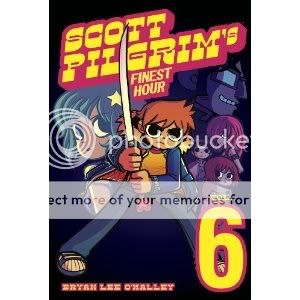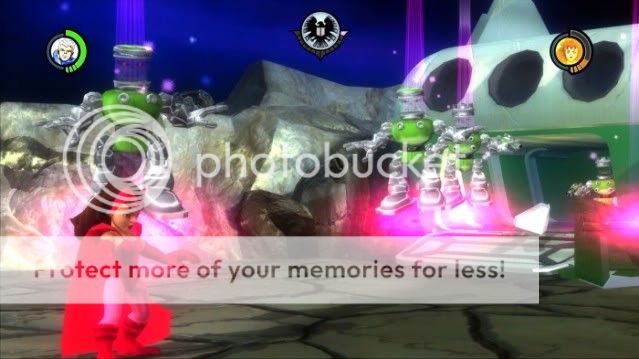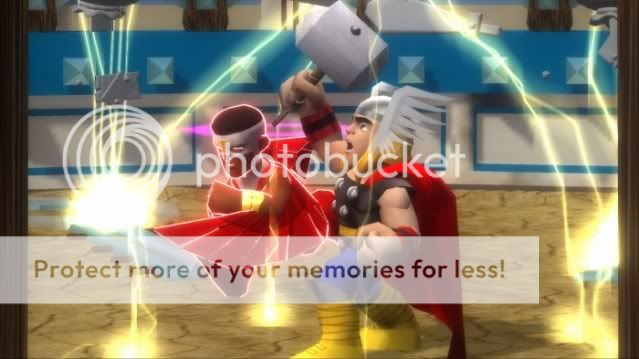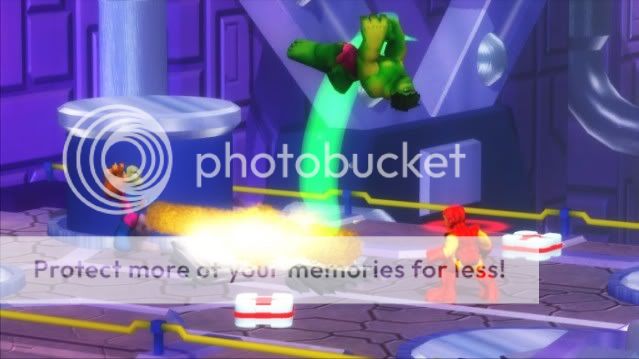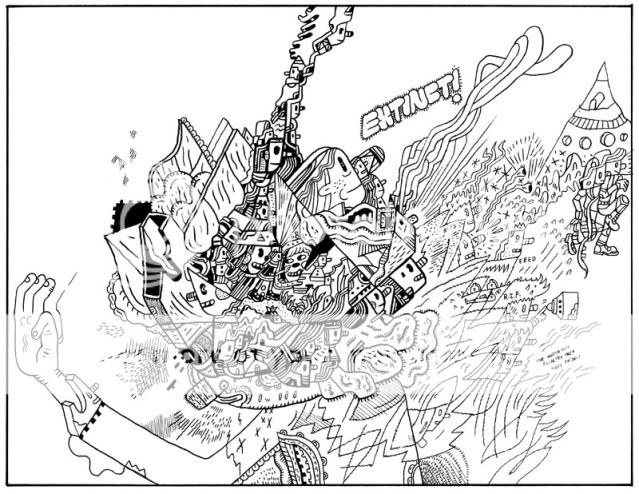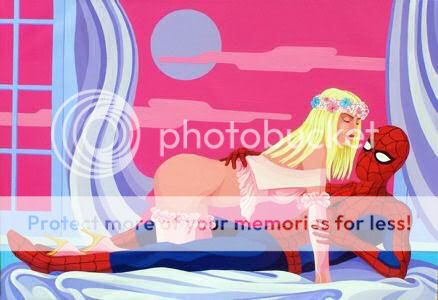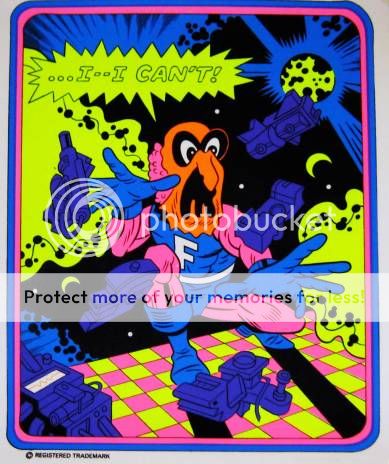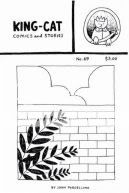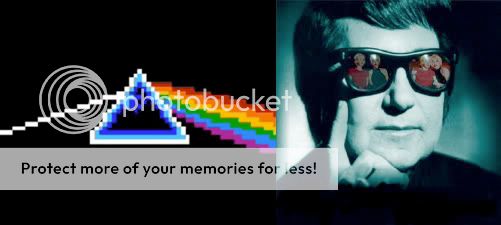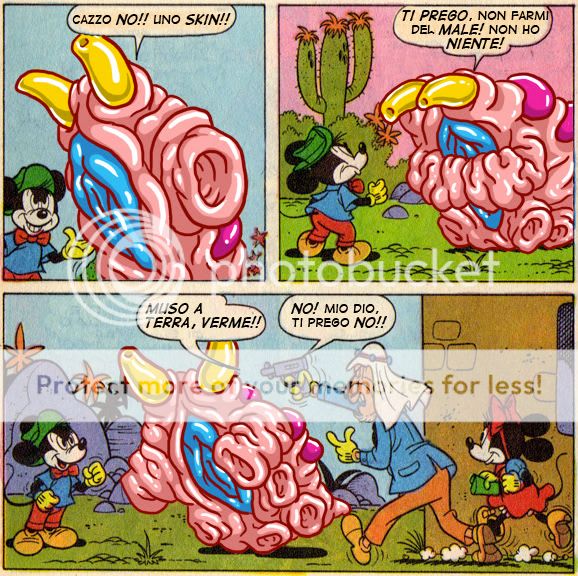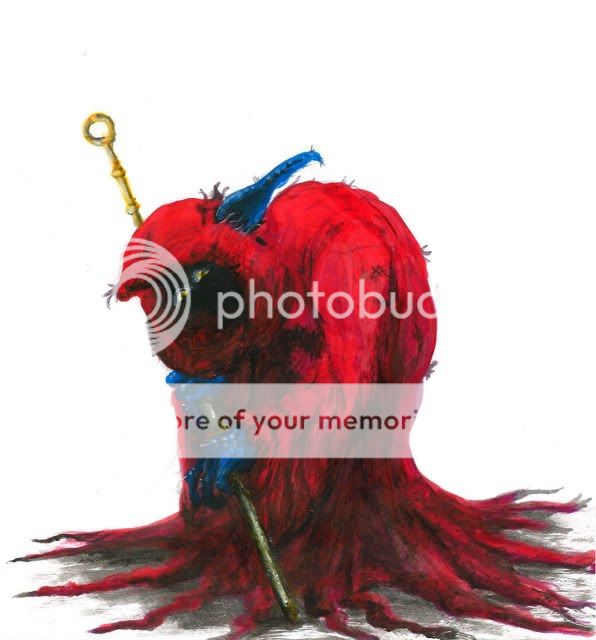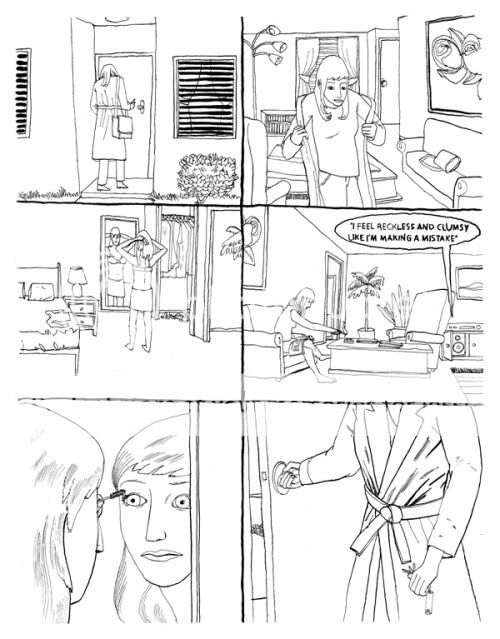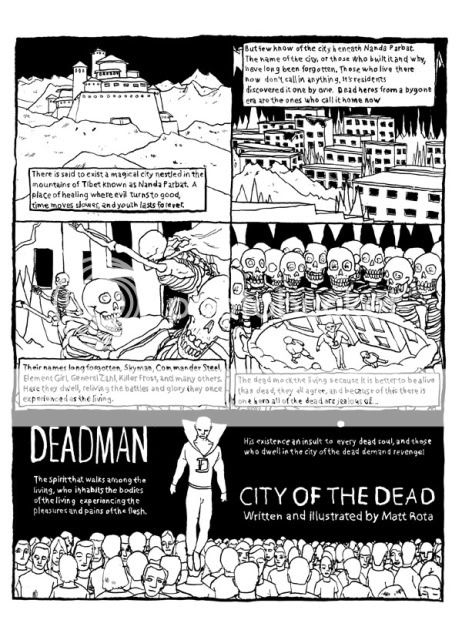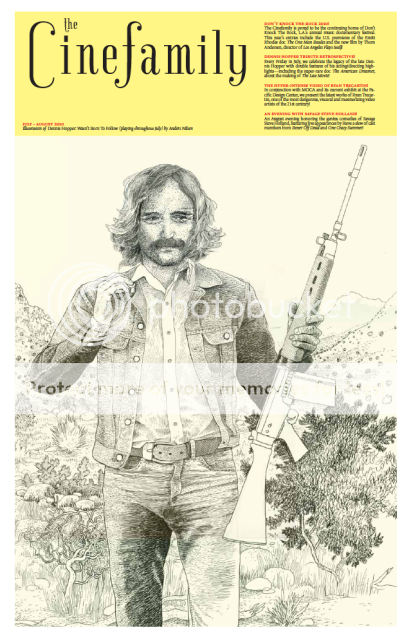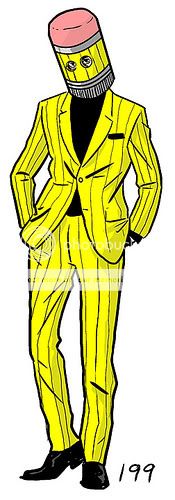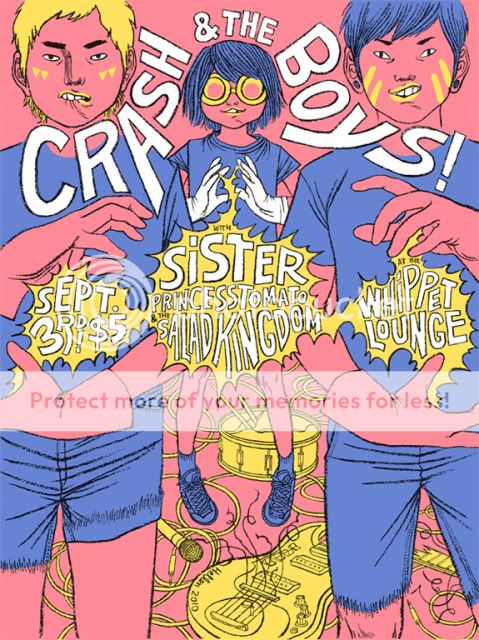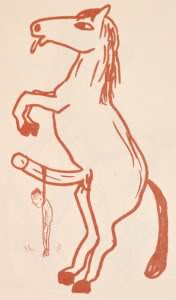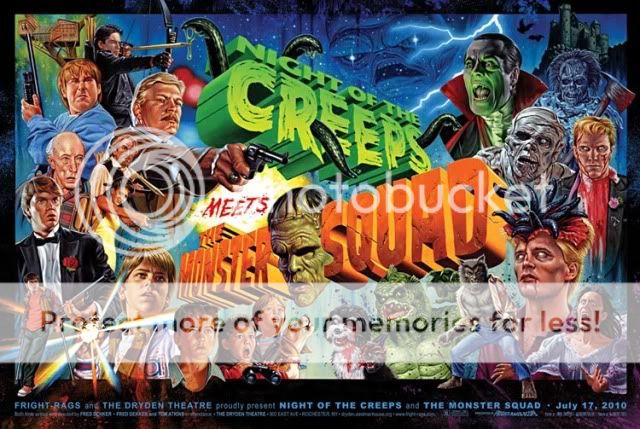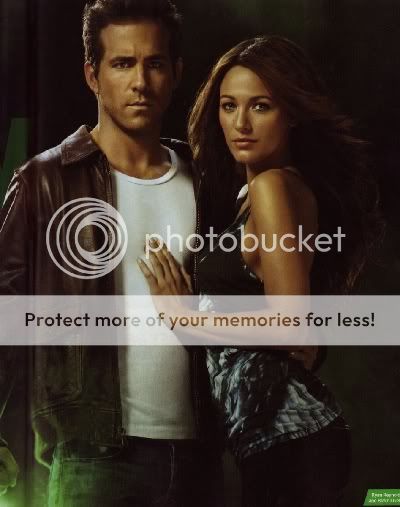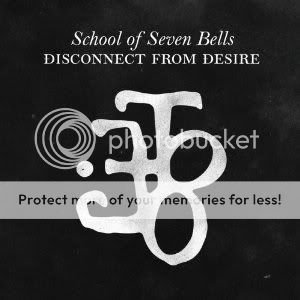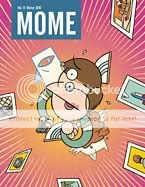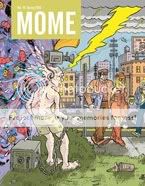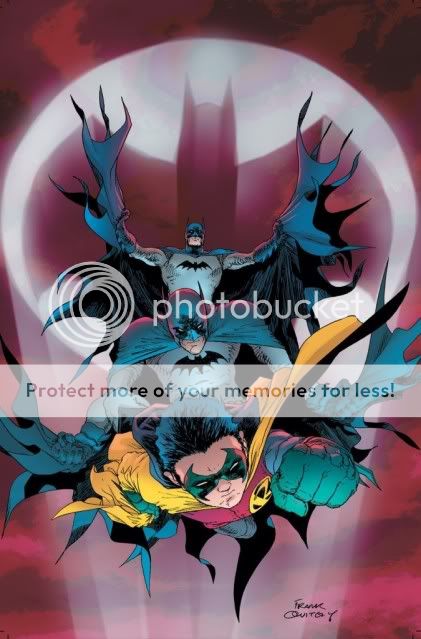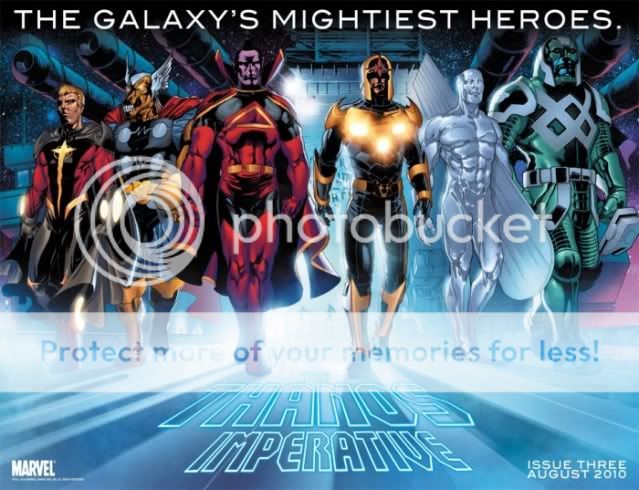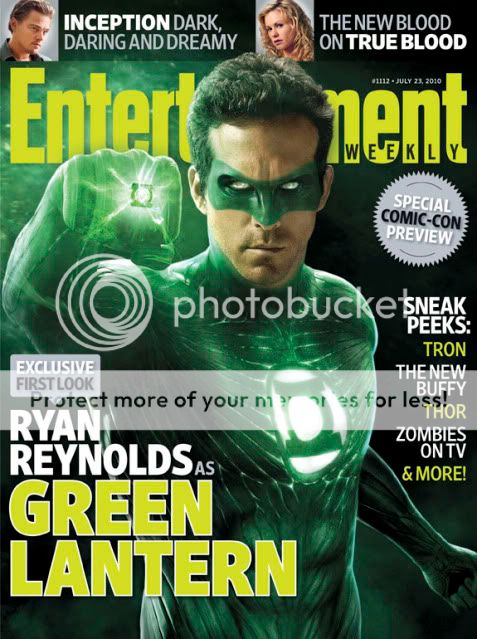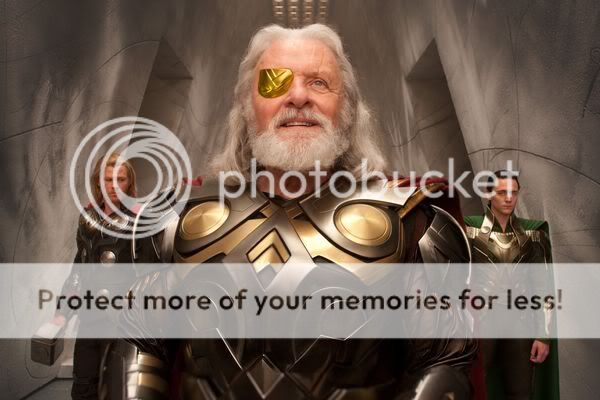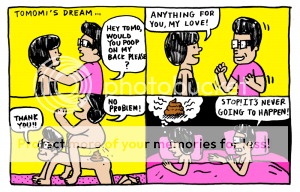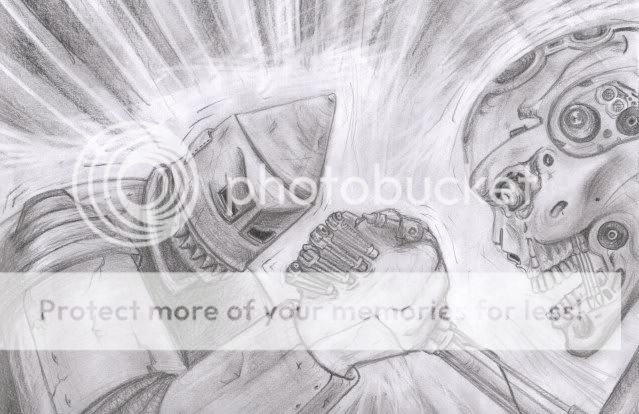Archive for July 23, 2010
Comics Time: Scott Pilgrim Vol. 6: Scott Pilgrim’s Finest Hour
July 23, 2010Scott Pilgrim Vol. 6: Scott Pilgrim’s Finest Hour
Bryan Lee O’Malley, writer/artist
Oni, July 2010
248 pages
$11.99
Or: Scott Will Eat Itself. The gist of this final volume in Bryan Lee O’Malley’s worlds will live/worlds will die/comics will never be the same series is that it’s an extraordinarily bad idea to reduce the people in your life, even the people who used to be in your life, to stock roles in the beat-’em-up videogame or shonen manga you’ve mentally conceived your life to be. Not only is this cruel and reductive to them, not only will it cause them trouble to the extent that you’re still in their lives and forcing them into that role when you interact, it’s cruel and reductive to you yourself, since it traps you in the corresponding role as well.
I mean, I guess that’s the gist. I’ve always had a hard time connecting with Scott Pilgrim on the personal, emotional level a lot of its ardent admirers do, mostly, I think, because I’m a creep. As I put it when discussing Vol. 5:
There’s no doubt that I’m speaking from my own experience with my own emotional life, which for whatever reason I don’t experience as a lot of rock and roll fun with the occasional bummer mixed in, even if that is in fact a more objectively accurate view of what my life has been like. Maybe it’s just a preference thing, maybe I feel like darker material more accurately reflects what is important/lasting in life/art, I don’t know. I do know that I don’t see my life as a rollicking adventure, or more accurately, something that might be a rollicking adventure were the occasional metaphorical robot fight thrown in.
The long and the short of it, especially in a volume such as this, which wraps up an entire series’ worth of emotional arcs in the form a massive, bloody (!) swordfight, is that Scott and his friends are characters whose adventures I can enjoy even if I can’t personally really understand the thought process underneath them. Like, look, O’Malley’s art has never been better than it is in this volume, which is pretty much true every time–the climactic fight scene occupies about two-fifths of the book and has oomph galore, and I think O’Malley deserves some sort of special Eisner Award for the potential Envy Adams cosplay opportunities created here. And it’s difficult to overstate the subspace corridor opened in my head over these past few years by his overall mix-and-match aesthetic, from its non-traditional, designy use of captions and text to tell the story, to its no-explanations mix of romance and action, to his often laugh-out-loud funny dialogue and sense of timing, to most especially his incorporation of videogame tropes–just a vast reservoir of completely underutilized visual vocabulary and storytelling potential. So if, in the end, Scott Pilgrim isn’t my life, I sort of feel like the last thing Scott Pilgrim would want is for me to pretend that’s the role it played.
Carnival of souls: Special “San Diego Comic-Con Day One” edition
July 22, 2010* Comic-Con International 2010 opened up yesterday in San Diego and had its first full day today. A ton of news and news-esque substances come out of the show every year. To follow it all I’d recommend clicking here for Comic Book Resources’ complete coverage and here for Robot 6’s slightly more curated and comics-centric coverage and here for Spinoff’s movie and TV-centric coverage. Those are the sites I’m following, and of course I’m writing for Robot 6 as well.
* So far Tom Spurgeon has reported a ton of actual news about good comics right from the show floor, which is astonishing in its way. The wording’s unclear, but for me the big news from that report is that (I think) Jordan Crane’s one-man anthology series from Fantagraphics Uptight is ending after its next issue.
* Strange Tales II is on the way from Marvel, featuring Los Bros Hernandez, Harvey Pekar, Frank Santoro, Rafael Grampa, Jillian Tamaki, Kate Beaton, Jon Vermilyea and many more.
* DC Comics may move to Los Angeles. I hope they make the decision soon so that the employees aren’t left wondering for another year or so.
* Fred Van Lente is writing a new Power Man & Iron Fist book. The Power Man in question isn’t Luke Cage, but still, a new Iron Fist ongoing is fine by me.
* Is there anything lovelier in all of comicdom than a fully-stocked Fantagraphics convention table?
* I just love these screenshots from the freshly announced Marvel Super Hero Squad: The Infinity Gauntlet videogame. I’d read a comic that looked like this.
* Now Tom Devlin is writing in-character Dakota Fanning as Cherie Currie/Alexis Bledel as Rory Gilmore femmeslash as part of his previously established Edward Cullent/Michael Cera-verse. Peggy, is there something we need to be told here?
* In “sort of interesting things that might eventually happen one day” news, maybe They’ve cast Brad Pitt in the movie They might make of Max Brook’s World War Z and maybe They’ll make a movie out of Kurt Busiek and Brent Anderson’s Astro City.
* Wow, someone in the Green Lantern art department sure loves the “Bodies” exhibit.
* BREAKING: Major studio manages to assemble two minutes of reasonably entertaining footage from two-hour science-fiction-fantasy-action-CGI blockbuster with teal-and-orange color scheme.
* In non-Con news:
* Good for Alan Moore for rejecting DC’s offer to give him back the rights to Watchmen if he agreed to sequels and prequels. I’m with Steve Ditko on this sort of thing: A is A. Either the book rightfully belongs to Moore, in which case you should give it back to him yesterday no strings attached, or it doesn’t, in which case who cares. But clearly someone does care enough to feel bad about the current state of affairs, which is an indication that, well, A is A.
* Tons and tons of Scott Pilgrim music is on the way.
* Ron Rege Jr./Marc Bell jam piece!
* Does Dave Kiersh draw the sessiest ladies in comics?
* Scott Tobias’s New Cult Canon series at the Onion A.V. Club tackles American History X. I admit I did a Find for “curb” immediately upon opening the page.
* Finally, here are paintings of Wonder Woman masturbating and Spider-Man preparing to make love to Cicciolina, by Giuseppe Veneziano. “Cicciolina, Cicciolina, Cicciolina per l’Italia!” (Via Spurge.)
Music Time: Janelle Monae – The ArchAndroid
July 22, 2010Janelle Monae
The ArchAndroid
Atlantic, May 2010
Here’s something I should like, right? Science fiction you can dance to! The ArchAndroid is part of an ambitious concept multi-album project inspired by Fritz Lang and involving outfits out of Klaus Nomi’s wardrobe, channeled through the idiom of contemporary R&B yet looking and sounding like basically nothing on the radio, sung by a woman with enough confidence to make even her deal with Diddy sound like “I say frog, Puffy jumps.” I stuck this record on expecting to celebrate my way through it.
But something happened on the way to Metropolis. Making my way through The ArchAndroid–which I’ve now studiously done several times, convinced I must be getting something wrong–wasn’t the Ziggy Stardust Meets the Mothership dance party of my dreams, it was an endurance test. Right up front, a big part of that’s Janelle Monae’s voice, strident and sharp any time she goes for the big loud sound, which is often. Vocals play the same role in pop music for me that a cursory flip-through of the art alone does for comics: If my ear/eye bounces off or glazes over, then to heck with it, life’s too short. That was hard to get around. So too was the lack of simple, solid melodies, hooks, or grooves. It was as if Monae didn’t trust the basic stuff of pop songwriting as a sufficient demonstration of the breadth of her interests.
And that points to the big problem with The ArchAndroid: It’s practically a case study for the perils of the maximalist aesthetic. Monae slides song into song, collides genre into genre, and just keeps adding adding adding adding adding in a fashion that creaks and growns with its effort to be Intelligent And Entertaining!!!, ultimately revealing her to be a jack of all trades but master of none. So I’m taking The ArchAndroid song by song below, an approach practically demanded by the sheer volume of stuff inside….
* “Suite II Overture”–A melodically inert orchestral introduction that serves no purpose other than to say “Look, it’s an orchestral introduction”
* “Dance or Die”–That “BadabadabadabadabadabadaBA” emceeing wears out its welcome within the first verse; Saul Williams, who knows from overlong draggy albums, is much more flattered by the pummeling production Trent Reznor lent the first few songs on Williams’s own Bowie-indebted album The Inevitable Rise and Liberation of Niggy Tardust! than he is by this boho dinner-party hip-hop.
* “Faster”–What if you hurried “You Can’t Hurry Love”?
* “Locked Inside”–Here’s where the sharp vocals really started throwing me. A perfectly pleasant chorus, and I like the MJ bridge quite a bit, but we’ve heard that a million times. Britney Spears did it! Meanwhile the verses’ real estate is just squandered.
* “Sir Greendown”–Very mellow.
* “Cold War”–“Hey Ya”‘s rhythm with “B.O.B.”‘s drum sound. That’s definitely not a complaint. For the first time, the album conveys urgency without edging into stridency. Not a knockout, but the strongest so far.
* “Tightrope”–Very tough to argue with this one. But, well, okay. That opening “whoa!” is a little much–I’m guessing that how you feel about that will determine how you feel about the whole album. As an funkateer of some 12 years’ experience I was very excited by that horn section–it’s a horn section!–but calling attention to its funkiness by just straight-out calling it funky should be my job, not Monae’s. And whoop, here comes more maximalism–funny voices for the backup vocals, a goddamn ukelele. Edit!
* “Neon Gumbo”–The “played backwards” portion of the album. Prince by numbers.
* “Oh, Maker”–AM-radio chamber pop with a beat and a melodically meandering chorus, fade, some synth-psychedelia at the end.
* “Come Alive (The War of the Roses)”–Sounds like an outtake from I’m Breathless: Music From and Inspired by the Film ‘Dick Tracy’. And not like “Vogue” or one of the Sondheim songs, either. Then there’s some screaming.
* “Mushrooms & Roses”–Lenny Kravitzian psychedelic slow jam with “Hurdy Gurdy Man” vox. For people who wished The Love Below were even longer, I guess.
* “Suite III Overture”–Mostly a piano/orchestral cover of the previous song. I prefer it! Then it winds off into a Disney/exotica thing.
* “Neon Valley Street”–Is that a mellotron? I hope so. I dig the laid-back big beat and comparatively restrained vocals here. This also reminds me of Kravitz, specifically * “Sugar” from Are You Gonna Go My Way? Again, that’s not a complaint. The chorus’s repetition of “May this song reach your heart” leaves me kind of cold, though. I think the Andre 3000 distorted-vox rap section is fun.
* “Make the Bus”–Note salad from Of Montreal. It’s goofy!!! Zany!!!
* “Wondaland”–This is cute and has a great chorus. I keep hoping she’s saying “because she left her underpants.” An underwater feel to it. Let’s throw an Alleluia in there for no reason.
* “57821”–Parsely Sage Rosemary and Yawn. The chorus harmonies are lovely though, nice echoey production you don’t normally hear on this sort of thing.
* “Say You’ll Go”–1997 dinner-party music.
* “BeBopByeYa”–1961 dinner-party music.
Trust me, no one hates that this brought out the dismissive snark in me more than I do. It doesn’t even really deserve it! Whatever she lacks in execution, Monae’s ambition is praiseworthy, and provided she doesn’t let the plaudits she’s earned for this record go to her head, there’s every reason to believe that an artist of her obvious ravenous intelligence will learn to write stronger melodies–learn to relax and rely on stronger melodies, that is to say, learn to get out of her own way and edit a bit. But what happened here is that her whirlwind sci-fi tour of a million pop traditions just left me trying to find 18 ways to say I’m unimpressed.
Carnival of souls
July 21, 2010* I have been writing a lot of reviews of all sorts of things over the past week or so and some of my posts may have slipped past you if for some reason you weren’t paying rapt attention to my every move. Here’s what’s been going on:
COMICS:
* The Troll King by Kolbeinn Karlsson
* Batman R.I.P. by Grant Morrison, Tony S. Daniel, and Lee Garbett
* King-Cat #69 by John Porcellino
MUSIC:
* “Karaoke” by Drake (from Thank Me Later)
* Disconnect from Desire by School of Seven Bells
* Night Work by Scissor Sisters
* “Always Loved a Film” by Underworld (from Barking)
* “Crying for Us and Them” by Phil RetroSpector (from Mashed in Plastic)
MOVIES:
* Mullholland Drive by David Lynch
* And I also have a new comic up, in collaboration with artist Matt Rota, called “No.”
* Heidi MacDonald notes the location of the small-press area at San Diego.
* Speaking of San Diego, which I’ll be doing a lot, I’d imagine going and not seeing a Comic Relief booth would hit me pretty hard.
* Zack Snyder has begun working on the screenplay for Frank Miller’s 300 prequel Xerxes.
* Ooh, look, a Tim Hensley blacklight poster! (Via Flog.)
* Help PictureBox fix the Thor movie!
* Tom Devlin writes Twilight/Scott Pilgrim slashfic, for some reason.
* It’s been way too long since I’ve posted a picture of Kate Winslet for no reason. Well, other than the obvious reason. (Via Jason Adams.)

Comics Time: King-Cat Comics and Stories #69
July 21, 2010King-Cat Comics and Stories #69
John Porcellino, writer/artist
Spit and a Half, September 2008
28 pages
$3
In the right hands, comics don’t depict, they convey. This is the advantage they have over their cousin film. The basic stuff of film (putting aside animation and abstract filmmaking and CGI for the moment) is, on a fundamental level, the recording of things that actually happened in front of the camera recording them. Those recordings can be recordings of a fiction, and they can be used to construct a fiction, and directors and cinematographers and editors and composers and effects technicians can add their interpretive gestures, but film is nevertheless a hegemony of fact. Comics, by contrast, is all middleman. Even an autobiographical comic is by virtue of being a comic not showing you something that happened, but telling you about it, the telling coded directly into the line of the artwork. It’s a gestural art form, a mime medium.
No one gets that better than John Porcellino. Most lo-fi autobio cartoonists, perhaps paradoxically, aim for maximalist effect in terms of presenting the artist’s self-conception: shaky, rough-hewn lines, clumsy character designs, everything designed to get across “I’m self-effacing!” Porcellino stays out of his own way. With his smooth uniform line weight, characterized by elegant curves and semicircles, he presents information on a need-to-know basis, usually emphasizing human figures against a minimally depicted background (like a sky) or foreground (like a car window). He’s not conveying a pose, he’s conveying in-the-moment relationships: Between himself and his wife, between his two cats, between himself and a parking lot, between the grass and the sky. This happened, yes, but he allows you to draw the conclusion yourself–this is how it happened, this is how it felt in that moment. All that empty space allows you to place yourself between those lines. The effect is immediate, immersive, and evocative, so that when the poetic writing really hits–especially those frequently powerfully sad final lines–you can all but feel that world’s weight around you.
Music Time: Brad Smith – MOON8 / Phil RetroSpector – “Crying for Us and Them”
July 21, 2010Brad Smith
MOON8
self-released, March 2010
Download it or listen to it on YouTube here
Phil RetroSpector
“Crying for Us and Them”
from Mashed in Plastic: The David Lynch Mash-Up Album (bonus track)
1086 Productions, November 2008
I came to The Dark Side of the Moon late. Not until I was a junior in college, if I recall correctly, did countless comparisons with OK Computer finally prompt me to pick up a copy. So I have no smoky adolescent memories of listening the record in stoned and reverent awe in someone’s parents’ basement. Nor in someone’s dorm room, for that matter–by the time I got around to Dark Side I expect most of my running buddies had long since made their peace with the record. If you wanna talk about chemically enhanced communal journeys deep into the heart of Kool Keith’s Sex Style, I’m your guy, but my experience with Pink Floyd’s career-defining record has been mostly solitary, mostly sober, and mostly grown-up.
Indeed, the older I get, the more I listen to it, and the more it clicks with me. This is an album about the passage of time, the fear of failure, the drive to succeed, armchair warriors, mental illness, and death–about, in other words, my life over the past few years. And it’s not just that “The Great Gig in the Sky” sounds very different when you’ve gone through three consecutive miscarriages, though I promise it does, it’s that with age I can appreciate not just the relentlessly bleak lyrics but the intelligence of the music in which they’re packaged. One of the last great flourishings of true psychedelia–not a cheesy retro formless paisley swirl, but an overwhelming, all-encompassing onslaught of aural information–The Dark Side of the Moon‘s sound seems inexhaustible. Layer upon layer of studio wizardry and improvisatory instrumental prowess surround (mostly) simple rhythms, almost childlike melodies, and of course the disarmingly direct lyrics, cushioning the blow and making the darkness almost comforting. It’s an album to cling to, and that clings to you.
Lately I’ve listened a lot to a pair of Internet-based projects that run Dark Side through the prism of very of-the-moment musical…well, trends, you could call them, or gimmicks, or even parlor tricks given their inherently playful nature. Created first as a hobby and then as a birthday present, Brad Smith’s MOON8 is a chiptunes cover of The Dark Side of the Moon in its entirety. Smith transforms the Floyd’s lush, atmospheric, (ah, the hell with it) Floydian approach into the squeaky, squelchy sound of an 8-bit Nintendo-game soundtrack. This is really really easy to appreciate on a Tumblr-meme level, of course: Pink Floyd is awesome, Nintendo games are awesome, making Pink Floyd sound like a Nintendo game is a veritable double-rainbow of awesome. One level up, and (as Smith points out) it’s a fun way to extrapolate the coincidental similarity between old game soundtracks and the proto-programming loops of “On the Run.” One level past that, and it’s a clever blend of two traditionally communal experiences: Playing video games with your friends as a kid, and listening to Dark Side in a group–in Smith’s case, with his family. One level past that, and it’s a juxtaposition of the nostalgia of your childhood (Nintendo) with the nostalgia of your adolescence or young adulthood (discovering Floyd), which in all likelihood was a recapitulation of your parents’ adolescence or young adulthood (the original audience for Floyd).
None of that would matter, however, if the music didn’t end up being so surprisingly interesting. “I like the challenge of making something large fit into a small space,” Smith told Wired. “How much expression can you get from just the three oscillators of the NES?” Certainly a big part of the pleasure of MOON8 is discovering how your favorite sounds from the original album are going to be translated into the music of Mario and company, from the power-up and coin sounds that become the cash-register noises at the beginning of “Money” to the explosions and lasers (sorry, it’s hard not to hear it that way) that replace the big epic backing vocals on “Us and Them.” But reducing peak-of-their-powers David Gilmour, Nick Mason, Roger Waters, and Richard Wright to whatever you can fit into the rudimentary tools of the FamiTracker reveals as much as it replaces. “Breathe” becomes a cheeky, bouncy pseudo-funk track halfway between the Head Hunters version of Herbie Hancock’s “Watermelon Man” and the underground music from Super Mario Bros.; “Time” starts like a quest and ends like a losing battle. With so few distractions, the singsongy quality of Dark Side‘s simple melodies–as simple and timeless as “Ring Around the Rosey”–comes through, unveiling a heretofore hidden aspect of the original album’s power.
“Crying for Us and Them” is in a way a similar process of addition through subtraction, coupled with addition through plain-old addition. Created by Phil RetroSpector for Mashed in Plastic, an all-mash-up David Lynch tribute album, it combines David Ari Leon’s piano-only cover of “Us and Them” (from one of those countless “Piano Tribute to…” cash-in albums) with Rebekah Del Rio’s gutwrenching Spanish-language a cappella cover of Roy Orbison’s “Crying,” “Llorando,” from Lynch’s Mulholland Drive. Once again, this is some wheels-within-wheels stuff: A cover that translates a song from one musical idiom to another, coupled with a cover that translates another song from one language to another, combined to create a new song, which is itself a tribute to the pivotal scene in a movie preoccupied with doubles, shifting identities, personal re-creation, and the flimsy boundary between the real and the unreal. And oh, right, there are the original lyrics to “Us and Them”: “And who knows which is which and who is who?”
But here, again, beyond the conceptual hijinx, something interesting is being revealed about the music. Lyrically, “Us and Them” is a song about conflict, about the powerful fucking over the powerless, in no uncertain terms. “‘Forward!’ they cried from the rear, and the front rank died”–as blunt and angry a description of war as you’re likely to find, especially considering that given Waters’ history the war he likely had in mind was the Good War itself, World War II. But musically, isn’t it romantic? That gentle groove, that crooning saxophone, that piano like an inviting breeze…the first time I heard this song, off one of my dad’s LPs back in middle school, I put it on a mix for the girl I liked, thinking it’d be a great song to make out to. In that regard it’s probably the clearest articulation of Dark Side‘s project of using warm, intoxicating music to say awful things. “Crying for Us and Them” takes advantage of Leon’s bare, pretty arrangement to reinvent “Us and Them” as a love song for real, only it’s now layered with the vocals of perhaps the most devastating lost love song ever recorded. A personal apocalypse on par with any of the Big Questions tackled by Dark Side–one just as tied to adult failure and regret. I was alright for a while, but the sun is eclipsed by the moon.
Carnival of souls
July 20, 2010* Even though there’s nothing more depressing than the phrase “Buenaventura Press Gone Out of Business Sale,” I’m glad Alvin will be at San Diego, and it sounds like he’s bringing quite a treasure trove with him.
* Dan Nadel reports that Ben Jones is in Los Angeles to work on his Adult Swim show, which is great news because I thought its defeat in that online contest meant it was dunzo.
* Every so often the Internet collectively decides that an interview with a celebrity between whose brain and mouth, to paraphrase Hesh Rabkin, exists no interlocutor is worth your time. Once again the Internet is totally right–you really oughta read Dan Fierman’s interview with Bill Murray in GQ. Did I mention it features a portrait of Murray by Daniel Clowes? (Via Tucker Stone.)
* Vacon Sartirani’s “Mickey Mouse Against the Worms” is fucking me up.
* I give you Orko by Adam Kropinak. I think my favorite part of this is the faded, barely visible O on his cloak, like it’s some ancient rune the meaning of which is lost to time.
* Now that I’ve finally seen Mulholland Drive, it’s time to gorge myself on all the writing about the movie I’d avoided for lo these past nine years. Here’s Matt Zoller Seitz. Here’s Salon’s guide/FAQ kinda thing. Here’s Michael Joshua Rowin and Michael Koresky from Reverse Shot.
* And here’s Robyn wrecking shop on Letterman with “Dancing on My Own,” one of the best songs of the year. “I’m in the corner, watching you kiss her.” (Via Pitchfork.)
“I can see his face.”
July 20, 2010Here are some thoughts on David Lynch’s Mulholland Drive. I really don’t want you to read them unless you’ve seen the movie. Probably best if you’ve seen Lost Highway and Twin Peaks as well.
* I can’t imagine this is a novel observation, but this movie is basically the Rosetta Stone for Tim & Eric Awesome Show, Great Job. From the opening jitterbug sequence and its swing dancers crudely superimposed over a flat neon pink greenscreen background, to an illicit sexual romance in a huge and soulless Los Angeles mansion, to tiny little people emerging out of nowhere, to its overall positioning of uncomfortable material on the precipice between comedy and horror. Tim and Eric have talked about Lynch’s influence in the past, and they’ve cast Ray Wise so it’s not like it’s some big secret, but having now seen this film specifically, I see just how direct that influence is.
* I got into this a bit with Matt Maxwell on Twitter, but this sure seems like an anti-love letter to Los Angeles, doesn’t it? I know that’s a facile reading. I’ve long defended Lynch against detractors who claim things like Blue Velvet and Twin Peaks are cheap sophomoric “look, suburbia/small-town America is FUCKED UP!” posturing, so I want to make it clear that I don’t think this is a similar case only it’s L.A. that’s eeeeevil this time. Still, in Twin Peaks in particular there is clearly much that both the characters we see as trustworthy moral arbiters, and by implication Lynch and Mark Frost, see as good and worth preserving in their small town. I don’t get that at all in Mulholland Drive The only people who seem happy with Los Angeles in this movie are either naive dupes or amoral assholes, or worse, of course.
* And there are additional cues, if not clues, that there’s something wrong with this place. The elderly couple who escort Betty from the airport and wish her luck are revealed almost right away as…not…right. Their glee over Betty’s arrival comes across like Minnie and Roman Castevet happily welcoming Rosemary into the Bamford. And the man behind the diner^…”There’s a man. In back of this place. He’s the one who’s doing it.” Given what happens at the end of the film, he’s like the black beating heart of the city, the font from which the rest of the monstrousness springs. And he’s right there behind the Winkie’s. Say what you will about Glastonbury Grove and the Black Lodge, but they weren’t right behind the Double R.^^
* To use a favorite expression of mine, one thing that really struck me is how my experience with Lynch’s past work–not to mention my own generic preoccupations–had me looking at hoofprints and thinking of zebras. Once you’ve seen Twin Peaks, Fire Walk with Me, and Lost Highway, it’s so tempting to see the elderly couple, the man behind the diner, and of course the Cowboy as agents of the supernatural, corrupting and destroying the innocent and surrounded by doppelgangers like a rock thrown into a pond is surrounded by ripples. After all, seeing Lost Highway‘s Mystery Man as a descendent of BOB, the Man from Another Place, the Giant, and Mrs. Tremond and her grandson, if not an actual resident of the Black Lodge appearing in an unofficial Twin Peaks sequel, is just as valid an interpretation of the events of that film as any other. So too, I thought, here.
* But! Once I did a little googling and came across the theory that the final fifth or so of Mulholland Drive is the terrible reality Diane attempted to mentally escape with the fantasy/dream that constitutes the rest of the movie, constructed Wizard of Oz^^^ style as her mind’s remix of the truth, it all clicked. No need for the Lodge. Unless of course imagination is the fifth dimension, Batman R.I.P. style. ^^^^
* No need either for other elaborate theories. One that I quickly came up with and then discarded was that somehow Diane too was suffering from amnesia, and Coco and everyone else were for some reason playing along with her delusion. Another was that Betty was a performance by Diane, concocted to further torment Camilla. She is a great actress, after all.
* A couple days later, the part I can’t get out of my head is how long it takes Adam and Camilla to announce their engagement in front of Diane. The pause between each phrase, the giggling, the meaningful glances…it’s just unbearably awful. What a fucking scene.
* The movie’s great achievement as a narrative, I would say, is in getting you to not only prefer the portion that isn’t “real,” but to make it feel more real to you than the reality. In discussing the film with my wife immediately afterwards, she said that compared to Lost Highway, the characters after the dividing line were far less fleshed out. And this is true, even though when you take a step back and look at it, their behavior was far more “realistic” than that of the Nancy Drew noir characters. But you end up believing the lie more than the truth. I’ve read some people who argue that this trick takes advantage of the simple fact that we’re fondest of those we’re introduced to first. The Psycho trick, in other words. It’s smart filmmaking.
* The Winkie’s dream sequence: As good as I’d heard. And by good I mean I reacted by saying “Ohhhhh, no, that’s no good,” and then rewinding it on behest of my wife to subject ourselves to it again. I remember doing that one time before: with the first subliminal flash of that face in The Exorcist.
* Also as good as I’d heard, better even: the sex scene. Lynch’s sweetest and not coincidentally his hottest. Just another explosion, another sense to inundate and overload.
* Submitted: The ending of this movie would have been the only other acceptable ending for The Blair Witch Project.
* This is horror, to me. This is the horror I want. Shining black and awful and unbearable, like a crack in the world that should never have been opened. Magnificent.
^ By the way, a filthy hirsute homeless man who reappears at the end of the movie to take possession of a sinister magic box that transports the person who opens it to another plane of reality? I can’t be the only person who thought of Hellraiser, can I?
^^ Speaking of which: the coffee at the Double R = “damn good”; the espresso at Ryan Entertainment = “shit.” Case closed!
^^^ “Pay no attention to the man behind the diner!”
^^^^ Lynch’s influence on Grant Morrison’s Batman work and Final Crisis is clearer to me than ever as well. And not just in the general “it’s creepy, it’s weird, it doesn’t make sense” way — the specifics, the preoccupation with shifting identities and doppelgangers, the conception of evil as a corrupting hole in the world.
Music Time: Underworld – “Always Loved a Film”
July 20, 2010Underworld
“Always Loved a Film”
from Barking
Listen to it on Pete Tong’s July 16, 2010 radio show (cue it up to 33:40 or so)
Boom-BAP boom-BAP boom-BAP boom-SSSLAP –man, I’m really into this beat, how they drag out and delay that fourth clap. It makes it sound tangible and physical and stretchy, giving the song’s bouncy pace a real push and pull. And this is one of the song-iest dance tracks Underworld have done in years: intro, verse, chorus, verse, chorus, bridge, chorus, fade. The song starts by repeating the words “the rhythm” over and over! The bridge features a passionately strummed acoustic guitar and the phrase “And I don’t know if I love you more than the way you used to love me”! The chorus is just the repetition of the words “Heaven” and “Can you feel it?”! Certain lyrics rhyme! Perhaps credit goes to the production team of Mark Knight and D. Ramirez, who’ve previously worked with the band and are among several more straightforward acts drafted to spice up the songs on Underworld’s upcoming, collaboration-driven album Barking. But Karl Hyde and Rick Smith have been working together for 30 years, fully a third of which was spent in pop bands, and over the past few years the huge widescreen sound for which they’ve become known has increasingly incorporated their old tricks–less panoramic, a more concise structure, an emphasis on the immediate oomph of the sounds. There’s still a tension between the minor-key music and the heaven-in-a-moment-lyrics, lest you think this is just pandering. But regardless, I’m just as happy to have an Underworld song with a chorus you can sing along to on the first listen as I am to have one made for staring out the window of a train and watching the world blur.
No
July 19, 2010Here’s a new comic I wrote and Matt Rota drew for our Cage Variations project called “No.” This is maybe the most varied of the variations. I hope you like it.
And here you can find some drawings from another Variation, “I Was There and in Some Ways I Still Am.”
Carnival of souls
July 19, 2010* Comic-Con is delaying its decision on whether to stay in San Diego or move to Los Angeles or Anaheim until after this year’s show. (Ha, “Schrodingers Comic-Con”!)
* Today on Robot 6: C.B. Cebulski gets a promotion;
* Tom Brevoort mulls bringing back the split book;
* The announcement I’d love to hear in San Diego this week;
* and Johnny Ryan reveals the cover for Prison Pit Book 3.
* Anders Nilsen draws Dennis Hopper.
* Renee French draws this charming young fellow.
* Dennis Culver keeps drawing Batman villains!
* These gig posters for fictional bands from Scott Pilgrim are pretty terrif. Here’s Hellen Jo’s.
* Kevin Huizenga presents the real cover for The Wild Kingdom.
* Might Kenneth Branagh’s Asgard be pretty interesting after all?
* Go buy stuff from the great Geoff Grogan. Especially Look Out! Monsters, that thing’s really special.
* I like this bit from this Ken Parille post on R. Crumb’s Genesis: “The wonder of Crumb’s Genesis is not the unknowable wonder of God’s ways but of people’s actions as the bible recounts them.”
* Hey, neat, Tom Neely is sharing a table in San Diego with my Partyka chum Shawn Cheng.
* There’s something really fitting about Theo Ellsworth drawing with Craig Thompson.
* I realize that “what Tom said” might as well be the name of my blog nine times out of ten, but what Tom said.
* I don’t know what this Lake Mungo movie Jason Adams is talking about is about, but it’s apparently a first-person horror mockumentary involving a lake, and I’m interested because lakes are frightening.
* Man it’s bizarre that they’re putting a crucial epilogue for Lost into the DVD release instead of into the finale as it aired. Spoilers at the link.
* It didn’t occur to me until I read this Graeme McMillan post on Will Smith’s upcoming vampire movie that Smith by rights should already have had a vampire movie under his belt, I Am Legend, and had that film stuck to its source material it would have anticipated the zeitgeist rather than felt like a belated jump aboard the zombie-apocalypse train.
* Zak Smith explains how he tries to cram every last nook and cranny of his D&D stories with something memorable, transformative, or both. Wouldn’t you like to see comparable adventure comics do the same? Couldn’t you rattle off the names of several that really coulda used Zach’s advice off the top of your head?
* 28 essays on Prince’s song “Purple Rain” by the same guy? Sure, I’ll eat it. (Via Douglas Wolk.)
* The Republican Party’s repeated intimations of militarization have disturbing implications.
* Will nothing ever live up to Jason Overby’s exacting standards?
* Remember that bit in The Fellowship of the Ring in the Mines of Moria, after they defeat the cave troll, where they run into the big hall and they get totally surrounded by like hundreds and hundreds of goblins, but then the Balrog roars all the way at the other end of the hall, and the goblins freak out and run away because they don’t wanna be anywhere near that place anymore, and Gimli laughs all cocky and brash because he thinks they were scared of him? Yeah, me too.
Music Time: Scissor Sisters – Night Work
July 19, 2010Scissor Sisters
Night Work
Downtown, June 2010
Ta-Dah, the Scissor Sisters’ second album, was the easy way out. Following the success of their self-titled debut and its inventive, irreverent pastiche of various and sundry ’70s pop and rock sounds–from mid-period Roxy Music luxe balladry to Elton John boogie to its masterstroke, a disco-fied Frankie Goes to Hollywood and Bee Gees-referencing cover of Pink Floyd’s sacrosanct “Comfortably Numb”–the group…churned out another album based on various and sundry ’70s pop and rock sounds. Only this time, gone was much of the inventiveness and irreverence. While the previous outing danced merrily along that fine line between subversion and celebration that powered the first four or five Roxy records, Ta-Dah was pretty much straightforward Eltonisms all the way. The attempts to juxtapose the happy and sad sides of the bacchanalian life they were chronicling felt obvious and forced: I don’t care if they got a huge smash out of it in England, doing a song about not wanting to dance, calling it “I Don’t Feel Like Dancing,” and basing it on an extremely danceable riff on Leo Sayer’s “You Make Me Feel Like Dancin'” is cheap-seat stuff. By album’s end, the would-be anthem “Everybody Wants the Same Thing,” the lyrics felt like a Rent outtake. There was still stuff to enjoy–the bass strut and huge middle-eight of “Paul McCartney” and the touching and tender love confession of “Might Tell You Tonight” taking top honors–but in the main this was dictionary-definition diminishing returns.
So that’s Ta-Dah. Here, in the words of frontman Jake Shears, is Night Work:
Well, I had a moment. I was at a sex party in Mannheim, I was on the dancefloor. It was six o’clock in the morning. I was wearing a little rubber wrestling singlet. I was having a great time. There was a cloud in the room, this cloud of man sweat, cigarettes, spilled booze, shit because people were getting fisted, and poppers. And piss! It was disgusting… The most vile place I’ve ever been. And I was dancing, and the DJs put on ‘Walk The Night’ by the Skatt Brothers. It’s one of my favourites. It was one of those revelatory moments for me when I realised what I wanted the album to sound like and how I wanted it to make me feel. Am I rambling? But that was the defining moment. My vision! My vision happened very clearly in that moment.
Sold! With that core concept in mind, Night Work is the sound of a reinvigorated band with balls to spare. Literally, at that: This is the sort of record I haven’t heard in a long, long time in that almost every song is a sort of double entendre where maybe it’s maybe not really about fucking but probably yeah, it probably is. There’s a song called “Harder You Get” that includes the lyric “Don’t point that thing at me unless you plan to shoot.” There’s a song called “Skin This Cat,” sung by Ana Matronic about the million ways she would like a gentleman friend to do so, in a tone that suggests she’s not talking about her Tonkinese. There’s a song called “Whole New Way” about finding a whole new way to love you that involves not being able to see your eyes and sneaking up from behind–and it bleeps and squelches sassily along like “Monkey” by George Michael to boot. I’d say “Do I need to draw you a picture here?”, but thanks to the album cover, it’s extra unnecessary.
To me, though, the ’80s-style wink-wink nudge-nudge smut is a lot of fun, but where the album really clicks is on the level of urgency. Its opening, title track barrels out of the gate with pulsing strings, strutting electric guitar, a relentless bam-bam-bam-bam beat and chirping high-pitched vocals that practically kick your face in with their manic intensity by the time the chorus comes around: “NIGHT! WORK! GOTTA DO THE NIGHT WORK! WEEKDAY NINE TO FIVE SHIFT IS OVER!” “Harder You Get” and “Running Out” provide a similar one-two punch pummeling later in the album, the former with a head-banging riff/chanted chorus combo and the latter with a breathless, jagged pace reminiscent of Devo at their tightest. There’s an overall willingness to go for it here that was sorely lacking on their last album, whether that means recruiting Sir Ian McKellen for a Vincent Price-style spoken-word monologue about “sexual gladiators” or bucking the wishes of both the label and the majority of the band itself to put a photo of a dude’s ass on the album cover.
Which leads to an important note: Both of the men involved in that picture–photographer Robert Mapplethorpe and dancer Peter Reed–died of AIDS. The menace lurking beneath the surface of Night Work is far less facile than, say, putting the words “we were born to die” on top of a jaunty Tin Pan Alley tune in Ta-Dah‘s “Intermission”–it’s more a subtle but repeated admonition that the bad comes with the good. “Remember this is what you asked for,” Shears warns on “Night Work”; “Stop crying like a child / You got what you want,” he says, repeating the sentiment, in “Harder You Get”; there’s a song called “Sex and Violence” that makes pretty much the same case Jane’s Addiction made on “Ted, Just Admit It…”. But the difference is that Shears and company ultimately come down on the side that it’s all worth it. The album ends with a quartet of very straightforward synth-heavy dance tunes, all four of which are tributes to love and a high-life so intense as to be transformative. You need a little danger to get there, and that’s reflected on Night Work from top to…well, you know.
Comics Time: Batman R.I.P.
July 19, 2010Batman R.I.P.
Grant Morrison, writer
Tony S. Daniel, Lee Garbett, artists
DC, 2010
224 pages
$14.99
Here’s a quick list of fun things found in this immensely enjoyable comic:
* Opening a story called Batman R.I.P. with a splash page which reads “YOU’RE WRONG! BATMAN AND ROBIN WILL NEVER DIE!”
* A bunch of weird supervillains from around the world sweeping into Gotham City to take it over as a joint venture
* Batman coming home from a long night of crimebusting to bang his gorgeous model/aristocrat girlfriend
* Robin thinking that’s kinda weird
* The Joker drawn as a nightmarish cross between the Thin White Duke, a Cenobite, and bell hooks
* Bruce Wayne’s girlfriend methodically explaining away the majority of the Bat-mythos as signs of debilitating mental illness
* Graffiti shutting down Batman’s brain
* A hunchback and a bunch of guys dressed like gargoyles pounding the snot out of Alfred with clubs
* Batman embedding within himself a back-up personality just in case his regular personality is in some way compromised
* Said back-up personality making a multi-colored costume for itself out of garbage and then running around braining villains with a baseball bat
* The central clue/metaphor being revealed as a pun on the femme fatale’s skin tone and hair color
* Said femme fatale’s leering facial expression when her villainy is revealed
* An impeccably choreographed martial-arts battle between Robin and a killer mime from France
* Villains who are all drawn look like they’re having the time of their lives until the precise moment Batman and his friends arrive to kick their asses, which they in turn are drawn to look like they were born to do
* Doctor Hurt repeatedly referring to himself as Doctor Thomas Wayne and no one believing him
* Jezebel Jet saying “What’s that sound?”–cut to a silent panel of her plane being swarmed by an army of Man-Bats
* Ending with a two-issue Lynchian psychogenic fugue induced by New Gods from Apokalips that simultaneously reincorporates the goofy old Batman adventures from the Silver Age and presents a bunch of shoulda-woulda-coulda alternative realities and ends when a chainsmoking orange person shoots a giant psychic lump of clay repeatedly because Batman has proven too awesome to psychically pirate and clone
A quick note about comments
July 16, 2010Recently I accidentally deleted at least two perfectly legit comments that I know of, and possibly more that I don’t. What’s going on is that the blog has been absolutely inundated by spam, and the creaky interface has made it difficult to impossible to prevent, which means I end up deleting literally dozens of spam comments in big purges throughout the day. I’ve accidentally caught a couple of for-real comments in these purges. I apologize to their authors, and to anyone who’s tried to or actually commented around here lately. I promise it was an accident–I’ve never deleted a single comment on this blog for content reasons.
Carnival of souls
July 16, 2010* For years now I’ve longed for someone to make a movie as scratch-your-eyes-out crazy as Rob Zombie’s fake trailer for Werewolf Women of the SS from Grindhouse, “starring Nicholas Cage as Fu Manchu.” Now Neveldine/Taylor, writer-directors of Crank and Crank 2: High Voltage, have signed on to direct Nicholas Cage in Ghost Rider 2, and provided the studio lets Neveldine/Taylor be Neveldine/Taylor, I may just get my wish.
* George R.R. Martin presents HBO’s complete factsheet on Game of Thrones, including everyone who’s been cast so far, all the writers, all the directors, etc. Getting excited.
* Here’s a Not Coming to a Theater Near You piece on Lost Highway, one of my absolute favorite movies of all time, that I’m going to avoid reading until I’ve seen goddamn Mulholland Drive, just in case.
* Tom Kaczynski draws Lightning Bolt.
* Raymond Sohn presents a brief survey of heta-uma style depictions of the penis. Viva la comix!
* I love this poster for a Fred Dekker night at in Rochester and I don’t even like Night of the Creeps.
* Ah, I knew there was a reason I was looking forward to the Green Lantern movie. “You’re Star Sapphire?” “(Sigh.) Look, Hal, I was gonna tell you…”
* Dead Wrestler of the Week is back with an entry on Road Warrior Hawk, my favorite pro wrestling archetype ever.
Music Time: School of Seven Bells – Disconnect from Desire
July 16, 2010School of Seven Bells
Disconnect from Desire
Vagrant, 2010
In addition to doing straight-up spoofs of specific songs, like “Eat It” or “Like a Surgeon,” “Weird Al” Yankovic does stuff he calls “style parodies.” These don’t sound like any one particular song from a given band or genre, they sound like the band or genre in general. “Dare to Be Stupid,” in which Al out-Devos Devo, is a style parody–and also a damn good song. The two concepts aren’t mutually exclusive at all.
“Real” bands have always known this. I could rattle off designer-imposter tracks that equal or better the work of their inspiration all the livelong day, from John Cafferty and the Beaver Brown Band recording the best song Bruce Springsteen never wrote in “On the Dark Side” to John Fogerty getting a run for his chooglin’ money by the Hollies and “Long Cool Woman in a Black Dress” (or Paul McCartney and “Band on the Run,” for that matter).
More recently, James Murphy took his Berlin-records fandom to newly literal lengths. On LCD Soundsystem’s This Is Happening he makes no effort to cloak the 1:1 correspondence between “Somebody’s Calling Me” and Iggy Pop’s “Nightclubbing,” or between “All I Want” and David Bowie’s “‘Heroes’.” Which is fine–heck, Bowie did it to himself on “Teenage Wildlife,” simply subbing in King Crimson’s Adrian Belew for King Crimson’s Robert Fripp. But for my money it’s the “style parody” style of “I Can Change” that works best. Here there’s no apples-to-apples comparison to distract or detract from Murphy’s work. Sure, you can hear unmistakable echoes of New Wave classics–the rhythmical bounce of “Fashion,” the rinkydink keyboard bleeps of “(Keep Feeling) Fascination,” the lyrical paranoia of “Are ‘Friends’ Electric?”, the two-chord trot of “Messages,” et cetera et cetera. You’re supposed to hear them, in fact; it’s more than just referencing a sound a la Goldfrapp, it makes you think “Man, what song does this sound like? It’s on the tip of my tongue…” But ultimately it’s not any one thing, it’s its own new thing, sturdily constructed from the blueprints of old things. It’s easy to sound like the stuff you like; it’s harder, and much more rewarding, to feel like it.
That’s what I’m getting from Disconnect from Desire, the new album from School of Seven Bells. The key here is that the sound that Benjamin Curtis and the Sisters Deheza are working with is one of the most returned to, sought after, downright hungered for sounds around: the danceable dreamscape of My Bloody Valentine’s “Soon.” I mean, people talk about looking for stuff that lives up to Loveless like junkies looking for a fix or ufologists desperate for a close encounter; if I myself had a nickel for every time I got stuck in a “cathedrals of sound” k-hole with “Vapour Trail” on repeat for eight hours, I’d have at least fifty, fifty-five cents. The problem, though, is that a sound as distinct as Kevin Shields’s or the 4AD catalog’s is so easy to mimic that you can coast on that mimicry. You hit everything on your swirly/sexy/shoegazey checklist and call it a day.
School of Seven Bells, on the other hand, does things differently enough to be able to afford, and make the most of, those stylistic similarities. For starters, these aren’t the murmured coos of Bilinda Butcher or the private languages of Liz Frazer–Alejandra and Claudia Deheza’s vocal harmonies are crisp, clear, and foregrounded, rhythmically emphasizing individual words and syllables. It’s an approach built to match the lyrics, which are equally economical and direct. “I want you / To know that / I loved you” goes the simple, sad chorus of “I L U”–three phrases, three words per phrase, all delivered clean and cool. In “Camarilla,” the vocal melody descends downward over the phrase “Life is luck of the draw then a battle of…wits”–the “of” sustained over several notes, then a pause, then “wits” delivered with a brief flash of harmony. You’d lose not just the wordplay if you drenched everything in reverb, you’d lose SVIIB’s unique juxtaposition of the grand romanticism of their sound with the relatable observations of their lyrics and the simplicity of their delivery.
Then there’s the sound itself. It too is dialed way down from the cacophonous guitar layers of Loveless. There are certainly big warm drones and sudden peals and notes that seem to echo out into some giant cavern, but it’s brought to life with beats more often than not. “Dust Devils” could strut comfortably alongside a poppy early ’90s rave act, “Heart Is Strange” pounds, “Babelonia” careens (at one point coming as close as anything on the album to referencing a specific song, Wire’s “Ahead”), “Bye Bye Bye” has a hook that’s practically freestyle. It’s as much synthpop as shoegaze, and it doesn’t just complement the pretty voices, it opens up the reference point to a whole time frame. This is the sound of, oh let’s say 1987 to 1991, pulling in mostly lost alt-pop sounds from Lush to Shakespear’s Sister to Sunscreem.
This all makes it sound like a clinical process of addition and subtraction, but the result is more alchemy than algebra. It makes me hungry for not just this sound in general but School of Seven Bells’ particular use of it. Cranking the “Be My Baby” beat of their “Joviann” makes me want to hear “Love’s Easy Tears,” yes, but mostly it makes me want to hear “Joviann” again and again. I want to feel that pounding, hear that guitar twinkle on up into the ionosphere, soak in the romantic mystery of that soaring, knowing refrain of “I used to know, I used to love….” I couldn’t do that if this were the Creation Records equivalent of “White & Nerdy.” They had to change things enough to successfully access that same space.
Comics Time: Mome Vols. 17-19
July 16, 2010Mome
Vol. 17: Winter 2010
Kaela Graham, Rick Froberg, Paul Hornschemeier, Tom Kaczynski, Dash Shaw, Laura Park, Olivier Schrauwen, Michael Jada, Derek Van Gieson, Sara Edward-Corbett, Renee French, Ted Stearn, Kurt Wolfgang, T. Edward Bak, Josh Simmons, writers/artists
Vol. 18: Spring 2010
Kaela Graham, Nate Neal, Lilli Carre, Dave Cooper, Gavin McInnes, Ben Jones, Frank Santoro, Jon Vermilyea, Ivan Brun, Joe Daly, Ted Stearn, Nicolas Mahler, Tim Lane, Conor O’Keefe, Michael Jada, Derek Van Gieson, T. Edward Bak, Renee French, Jon Adams, writers/artists
Vol. 19: Summer 2010
Kaela Graham, The Partridge in the Pear Tree, Josh Simmons, Olivier Schrauwen, Gilbert Hernandez, D.J. Bryant, Tim Lane, Conor O’Keefe, Robert Goodin, T. Edward Bak, writers/artists
Eric Reynolds, Gary Groth, editors
Fantagraphics, 2010
Vol. 17: 120 pages
Vols. 18-19: 128 pages each
$14.99 Each
Now that’s more like it!
Last time I checked in with Fantagraphics’ flagship anthology series–well, you could say one of two things about it: 1) That it lacked focus, or 2) that what it was focusing on just wasn’t remotely my cup of tea. Overly familiar underground schtick, humor pieces that didn’t make me laugh, whimsical work that lacked urgency and oomph, an overall identity crisis caused at least in part by high turnover among an ever-expanding line-up…Whatever it was, it bummed me out as someone who’s read the book from the get-go (and submitted to it a couple times!), and often forcefully advocated for it as the best buy in alternative comics not despite but in part because of the varying quality of the contributions, which enables you to directly observe the difference between what works and what doesn’t.
Now, though? It’s back in business. You can mostly credit the newer crop of contributors, a rough and tumble bunch who are bringing some fierce and hard-edged work to the table. Jon Vermilyea’s guest-artist turn in BJ and Frank Santoro’s Cold Heat-verse is brining out the funny, monstrous, horny, creepy side of that franchise more than ever before. Tim Lane’s nasty, Burnsian blend of noir and slice-of-life harkens back to the altcomix material that first made you uncomfortable when you first drifted over to the wrong side of the comics shop a decade and a half ago. Michael Jada is harnessing Derek Van Gieson’s sooty, watery black-and-white images to a tough-as-nails World War II story, of all things. Olivier Schrauwen has submitted his two best contributions thus far: a journey into the colonialist heart of darkness, and a C.F.-evoking tearjerker about the fantasy life of a man in a waking coma. Gilbert freaking Hernandez guest stars with a Roy story that’s good at everything Beto’s ever good at: character designs, dark skies, body language. Josh Simmons continues making a name for himself as one of the best in the biz with the start of “White Rhinoceros,” a cringingly funny cross between Alice in Wonderland and a Mel Gibson phonecall, with some of the best coloring this side of The Dark Knight Strikes Again. Robert Goodin returns with an impeccably drawn story of Carl Jung’s religious awakening, complete with giant god-shit falling from the sky and crushing a cathedral. Newcomer D.J. Bryant submits a story of a crumbling marriage that’s nasty in more ways than when–it’s straight-up porn, and good porn at that. And thanks to some perfectly evoked body language in an illo from Rick Froberg, Bryant’s story isn’t even the first memorable depiction of cunnilingus in these three issues!
I’m not on board with everything, of course. Paul Hornschemeier’s “Life with Mr. Dangerous” concludes as uneventfully as it’s continued; I’m an admirer of Hornschemeier’s work and it’s always lovely to look at, so I’m gonna reserve judgment for the eventual collection, but having that story wrap up feels like a welcome farewell to what Mome used to be. T. Edward Bak’s historical comic about the naturalist Georg Steller showed promise at first, but I’m thrown by the awkward way he breaks sentences mid-phrase from panel to panel or even page to page, and a story like this needs all the smooth-storytelling help it can get. Conor O’Keefe’s work is gently gorgeous to an almost ridiculous degree, but I’ve got no “in” to his whimsical world of boy-men in nightgowns. Nicolas Mahler’s amusing autobiographical anecdotes are the very definition of “nice, nice, not thrilling, but nice.” Much as I love seeing comics from Dave Cooper, his Pip & Norton stuff with Vice co-founder Gavin McInnes has always been his weakest. I’m equally cold on another comic duo, Ted Stearn’s Fuzz and Pluck. And the less said about Nate Neal here, the better–his two-page takedown of “hipsters,” for Christ’s sake, presents itself as though thousands and thousands of people haven’t spent the last decade doing exactly that (did you know they are pretentious? did you know they buy ugly clothes at vintage stores? did you know they live in Williamsburg? good lord) and is easily the most embarrassing thing that’s ever made its way into a Mome. (Which reminds me–it’s an anti-hipster piece in an alternative-comics literary journal. I feel like Elaine Benes shouting at toupee-wearing George Costanza when he refuses to date a balding woman: “You’re bald!”)
But the balance is definitely in favor of the strong stuff, because it is strong stuff–well drawn in a variety of styles, and potentially troubling without cloaking itself in shopworn tropes. Even the work that’s sort of middle-of-the-road in terms of the reaction it got from me has its moments, from the physical mechanics of the swamp creature Sara Edward-Corbett draws to the doll-like character designs and dramatic angles of Ivan Brun’s rather on-the-nose story of gun violence Jon Adams’s weird mash-up of Chris Ware fanfic and Stephen King short story. Once again, you’re getting your bang for your buck.
Carnival of souls
July 15, 2010* On Robot 6 today I put up a big round-up of Batman-related news that included the departure of Grant Morrison from Batman and Robin after issue #18 and this pretty sweet Frank Quitely cover.
* Here’s an interesting piece by Chris Butcher on the ground-level science-fiction manga series Twin Spica and how its cover is alienating its logical audience.
* I like the message of Douglas Wolk’s guide to Comic-Con for Techland: Do a little smart preparation and go in with reasonable expectations and the show will exceed them. (Via Tom Spurgeon.)
* Real Life Horror Headline of the Day: “Giant human-wounding plant invades Canada”.
* Straight-out racist, this Ghostbusters t-shirt is, simple and plain.
Music Time: Drake – “Karaoke”
July 15, 2010I have no brief with Drake. I’m led to understand he’s like Bizarro Lady Gaga: Like hers, his first album Thank Me Later (ha!) was recorded under the largely fictional conceit that he was already a huge star, but the Bizarro element is that in his case his reaction was to complain about fame’s dark side and downside rather than dress and act like a post-millennial Ziggy Stardust. That sounds funny to me, but I’m not sure if I’m laughing with him, if you know what I mean. As for his music, Thank Me Later‘s first two singles rely on dreary but relentless vocal hooks of the sort you hear without trying, without even wanting to. In today’s pop climate, that’s wisdom: If you want people to remember your music from the 10-second snippet they hear flipping around the radio or playing on someone’s cellphone, making it annoying is at least as effective as making it catchy. (He does get off one of the better lines in the wonderfully goofy “BedRock,” however. “I thought I recognized her…”)
But here’s the thing: “Karaoke” is the main reason I know any of that stuff. After discovering it through the mighty Fluxblog–well, it’s the sort of song that makes you hit up the artist’s wikipedia page. Drake performs this paean to a relationship that ended when his incipient stardom became too much for his beloved to bear against a loping drum beat and gently cooing synths (courtesy of Francis Starlite), his sung vocals echoing around and through them, his rap bouncing insistently up and down on the beat. The overall effect is to carve out a vulnerable, twilit space for his autobiographically direct lyrics. It could have seemed like the sociopathic emotional exhibitionism of reality TV or the dull narcissism of a bad autobio comic (to swipe Fluxblog’s comparisons), but instead it comes across like a quiet late-night conversation, when you’re too tired to be anything but totally honest.
In fact it reminds me of nothing so much as late-’90s Everything But the Girl, who pretty much perfected that blend of cool electronica and frank small-hours desire and regret. Listen to a track like “Good Cop Bad Cop” or “Before Today”: What’s striking is the exhausted need in Tracey Thorn’s voice, buttressed by blue Ben Watt production that sends the subliminal message “It’s okay, you can say this, I can hear this.” What I got from EBTG is what I get from “Karaoke,” right down to Drake’s Thorn-ian use of evocative everyday imagery (“You put the tea in the kettle and light it / Put your hand on the metal and feel it / But do you even feel it?”) and the way his description of his plight can be interpreted as a defense of and an attack on both involved parties (“I was only trying to get ahead, but the spotlight made you nervous”). My best guess is that the side of Drake that will become inescapable this year won’t be this side, but I’m happy to have found it at all.
Carnival of souls
July 14, 2010* Here’s a pretty quick and easy indicator of how tough a row Kenneth Branagh’s Thor movie has to hoe in terms of pleasing nerds: Topless Robot’s Rob Bricken dings the costumes worn by Thor, Odin, and Loki below for being too weird, while Comics Comics’ Dan Nadel dings them for being not weird enough. In terms of the history of Good Superhero Comics, that’s much more Dan’s territory than Rob’s, so advantage Dan if you have to pit them head-to-head; that said, I sympathize with Branagh and company for the tricky task at hand. You don’t just want to go straight-up Lord of the Rings faux-historical Viking warrior with them, but if you really went all-out Kirby/Simonson, you’d probably get a reaction akin to the one Speed Racer got.
* Speaking of the PictureBox empire, this is pretty funny: The site’s now hosting King Chubbo, that extremely filthy webcomic by Ken Sohn about him and his wife’s gross sex/fantasy life.
* Hey, look, Paul Chadwick has a blog. He says he’s working on a DC series with Harlan Ellison, a Dark Horse graphic novel with Mike Richardson, some Concrete short stories, a Concrete miniseries, a Concrete prose novel, and a kids’ series. (Via Michael May.)
* Alex Kropinak draws my Destructor character arm wrestling a Terminator. This is perhaps my favorite drawing.

